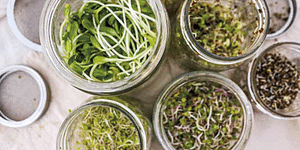Container Gardening 101: Growing Food In A Small Space

Do you dream of fresh produce at your fingertips but only have access to a small balcony or window sill? Do you have a community garden or allotment but still want more? If you answered yes to either of those questions, you should start container gardening!
Highly adaptable and hugely rewarding, container gardening is a great fit for city people with green thumbs.
The following is an excerpt from The Vertical Veg Guide to Container Gardening by Mark Ridsdill Smith. It has been adapted for the web.
What Is Container Gardening?

A container garden does not have to be large to be rewarding. These pots of mint, chives and parsley on a shady windowsill still provided me with fresh herbs nearly every day.
For those with itchy growing fingers in flats in the middle of the city, there are often three options: to get an allotment, help out at a community growing project, or grow in containers at home. All three are excellent in their own way and one often leads to another. It comes down to individual preferences, how much time you have, what community projects or allotments are available near you, and what, if any, growing space you have at home, so it’s worth quickly looking at the main differences.
Allotments are ideal for growing space-hungry vegetables, such as parsnips, Brussels sprouts, potatoes, broad beans, and larger fruit trees. They’re often lovely, quiet spaces to escape to at the weekend and on long summer evenings.
Travel there and back can eat into growing time (mine is just a 10-minute walk away, but that’s still a 20-minute round trip) and, with busy lives, many people find it hard to get there regularly enough. Most sites are friendly and welcoming, but check first as stories of allotment feuds aren’t uncommon.
Community growing projects vary hugely in character, resources and how they are run. The choice of what to grow and pick is usually made by the community, and this may differ from what you’d choose to grow at home. They can be wonderful places to help out, enjoy the community vibe, meet others and pick up local growing tips. If there are any near you, do check them out.
Benefits of Container Gardening
The biggest benefit of growing at home in containers is that the plants are on your doorstep. You can enjoy them every day, pop out and tend to them when you have ten minutes to spare, and pick what you want as you need it (it’s hard to overstate the value of this). Although the community benefits of growing at home are less obvious, they are still significant, as we will see.
The potential for growing at home will depend on the size and suitability of the growing space. Many small spaces can be highly productive, but please bear in mind that container gardens are less suitable for space-hungry crops like parsnips and Brussels sprouts and they do need more regular attention than allotments.
With container growing, you are also in complete control of how many pots you have and can therefore avoid the stress that a large allotment or garden often creates.
I grow in and love all three of these options. However, if I could only have one, I would grow in containers at home. Simply because I like having plants (and nature) on my doorstep where I can enjoy them and pick from them every day. I also enjoy the opportunity it gives me to meet other people in the immediate vicinity of where I live.
How Much Food Can Be Grown In A Small Space?
It’s possible to grow more food in many small spaces than is often realised. For example, in 2010, on my northwest-facing balcony in London, south-facing windowsills and a growing ladder outside the front door, I was able to grow 83.4kg (184lb) of food, worth approximately £899 in one year. This value was calculated using premium supermarket prices but justifiably, I think, on account of the quality of homegrown produce.
See ‘Table 1.1 Harvests from My Balcony and Windowsills in 2010′ to get a better idea of what we actually managed to produce and the equivalent number of supermarket packs – a lot of salad and herbs as you can see!
Of course, the amount that can be grown in a space varies hugely, depending on both its size and suitability for growing. Some spaces are sunny and sheltered, and ideal for plants to thrive; others present a challenge such as wind or shade that needs to be overcome first The shape and design of the space will also affect how many containers can be squeezed in and the weight of soil that can be supported. And size, of course, is very relative. I often talk about my ‘small’, 1.8 × 2.4m (6 × 8ft) balcony, but many flats have less outdoor space and some have none at all.
It often comes down to luck as to whether your space is good for growing or not. But, even in the least promising of spaces, it’s often still possible to create a worthwhile and rewarding garden, after a bit of trial and error. Container gardens do not need to be expensive, large or highly productive to give joy and change lives. Even just a few pots of herbs can be rewarding, add flavour and nutritional value to almost every meal, look pretty and smell wonderful, attract bees and other pollinators, and offer new opportunities to meet neighbours. For example, I once created a small kitchen herb garden with just three pots on a shady windowsill.
Recommended Reads
Recent Articles
Want to start your own medicinal herb garden? Passionflower, lemon balm, and goldenseal are great places to begin! These herbs are jam-packed with medicinal properties and easy to grow in a majority of climates.
Read MoreDoes the cold weather have you dreaming about fresh greens and colorful salad? Grow and harvest sprouts indoors to make those dreams a reality! Follow this quick start guide to year-round greens for fresh salad greens in just a couple of weeks! The following is an excerpt from Year-Round Indoor Salad Gardening by Peter Burke. It…
Read MoreAre you ready to get a jump-start on the gardening season? With a cold frame, you can get started now. A cold frame harnesses the sun’s heat before it’s warm enough to let unprotected seedlings growing outside. Essentially, it consists of a garden bed surrounded by an angled frame and covered with a pane of…
Read MoreSprouts are easy to cultivate, mature quickly and pack a nutritional punch! You can make nutrient-rich sprouts from all kinds of edible seeds in your kitchen.
Read MoreWant to make the most of the slow gardening season? Lay cover crops to improve the health of your soil and plants! The following is an excerpt from The Celestial Garden by Jane Hawley Stevens. It has been adapted for the web. Benefits of Cover Crops Cover cropping is a management practice that benefits the…
Read More










